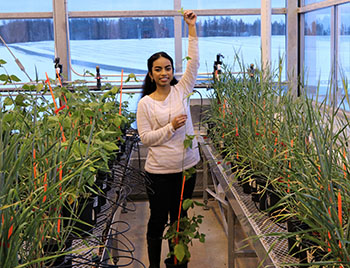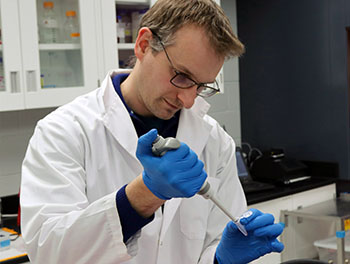Set up an interview
Media Relations
Agriculture and Agri-Food Canada
1-866-345-7972
aafc.mediarelations-relationsmedias.aac@agr.gc.ca
In 2019, Agriculture and Agri-Food Canada (AAFC) research scientist Dr. Adam Foster, located at the Charlottetown Research and Development Centre, was looking for a motivated student to join his team to explore the benefits of cover crops on cereal grain crop disease management. Cover crops are crops that are grown to benefit the soil and environment rather than being harvested for food.
Master’s student Harini Aiyer, from Prince Edward Island, had previously done laboratory work at the AAFC Ottawa Research and Development Centre while completing her undergraduate degree at the University of Ottawa. That stood out to Dr. Foster. Harini soon joined Dr. Foster’s team to help study how various cover crops would affect fusarium crown and root rot, a common and widespread fungal disease that affects root tissues, in barley and soybean crops.
“Cover crops are known to have beneficial effects like preventing soil erosion, being good for ground cover, and good for increasing nutrients available in the soil for crops. But there wasn’t as much information about their effects to the soil microbiome and how that contributes to preventing diseases like fusarium crown and root rot. That’s why I was interested in working on this project,” says Harini.
Digging deeper into the root cause
Dr. Foster and Harini tested 8 different cover crops that were planted during the summer a year prior to barley and soybean crops. They were sorghum Sudan grass, annual ryegrass, oilseed radish, brown mustard, alfalfa, crimson clover, buckwheat and phacelia. The team wanted to see how each of these cover crops affected the soil microbiome, the collection of beneficial and harmful microorganism communities living in the soil, and then whether the microbiome increased or decreased fusarium crown and root rot disease in next barley and soybean crops.
While working on this project, Harini explored the changes in the soil microbiome after planting cover crops. She then looked for disease the following year in barley and soybean planted into the same field plots. Dr. Foster helped Harini design the sampling schedule, the protocols for analysis, and the field and greenhouse trials. He also supported Harini with more challenging tasks such as extracting DNA from the crop residues. Recently retired AAFC research technician Ron Matters also provided significant expertise and support to the project. Even during the COVID-19 pandemic, Harini, Ron, and Dr. Foster continued to forge ahead on the project virtually and while physically distancing in the fields. Fortunately, agronomy and weed research on dozens of cover crop varieties led by AAFC scientists Dr. Andrew McKenzie-Gopsill and Dr. Aaron Mills gave Harini and Dr. Foster the opportunity to use these same fields of cover crops for their study and complete their research during the pandemic.
"Dr. Foster’s mentorship was huge for me. He was really supportive during the pandemic and throughout the entire project. That mentorship is a big part of science – getting the help when things go wrong and figuring it out together along the way."
- Harini Aiyer, student, Agriculture and Agri-Food Canada
The cream of the cover crop
Clear winners began to emerge as Dr. Foster and Harini started to dig into the data, but one cover crop stood alone in the top of its field, sorghum Sudan grass. Alfalfa and brown mustard were good at reducing fusarium crown and root rot in barley and phacelia was good for soybean, but sorghum Sudan grass was the best for both barley and soybean.
"When we got our microbiome data results back, we found that the quantity of disease causing microorganisms in the soil after sorghum Sudan grass was much lower compared to other cover crop soils. Plus, the microorganisms that are known to attack the pathogen that causes fusarium crown and root rot were higher. When we measured fusarium crown and root rot in barley and soybean the following year, it was much lower in the fields where sorghum Sudan grass was grown."
- Harini Aiyer, student, Agriculture and Agri-Food Canada
Harini also completed a greenhouse experiment using soil from cover crop fields to confirm that the cover crop was responsible for making the soil more suppressive to fusarium crown and root rot disease under high presence of disease. The sorghum Sudan grass soils had significantly less fusarium crown and root rot disease in the greenhouse-grown barley and soybean plants compared to other cover crop soils. Phacelia soil also did well for soybean, while alfalfa soil did well for barley, in the greenhouse experiment.
"What was interesting is that sorghum Sudan grass may be changing the soil microbiome to make it disease suppressive in future years. It’s increasing the beneficial microorganisms and decreasing pathogen levels in the soil leading to decreased fusarium crown and root rot disease in barley and soybean crops."
- Dr. Adam Foster, research scientist, Agriculture and Agri-Food Canada
Now at the AAFC Agassiz Research and Development Centre, Harini is 2 years into her Ph.D. at the University of British Columbia, continuing research on the soil microbiome and how it plays a role in sequestering carbon.
“I feel grateful to have been with AAFC at the beginning and throughout all of my research training. AAFC is a really great learning environment for students.”
Key discoveries/benefits
- AAFC scientist Dr. Foster and master's student Harini Aiyer were interested in seeing how various cover crops would affect fusarium crown and root rot, a common fungal disease that affects root tissues, in barley and soybean crops.
- They tested 8 different cover crops planted in the summer a year prior to barley and soybean crops – sorghum Sudan grass, annual ryegrass, oilseed radish, brown mustard, alfalfa, crimson clover, buckwheat and phacelia.
- Alfalfa and brown mustard were good at reducing fusarium crown and root rot in barley and phacelia was good for soybean, but sorghum Sudan grass was the best for both barley and soybean.
- Dr. Foster and Harini’s findings suggest that sorghum Sudan grass may be recruiting beneficial microorganisms in the soil microbiome that can then supress the development of fusarium crown and root rot disease in barley and soybean crops.
Photo gallery

